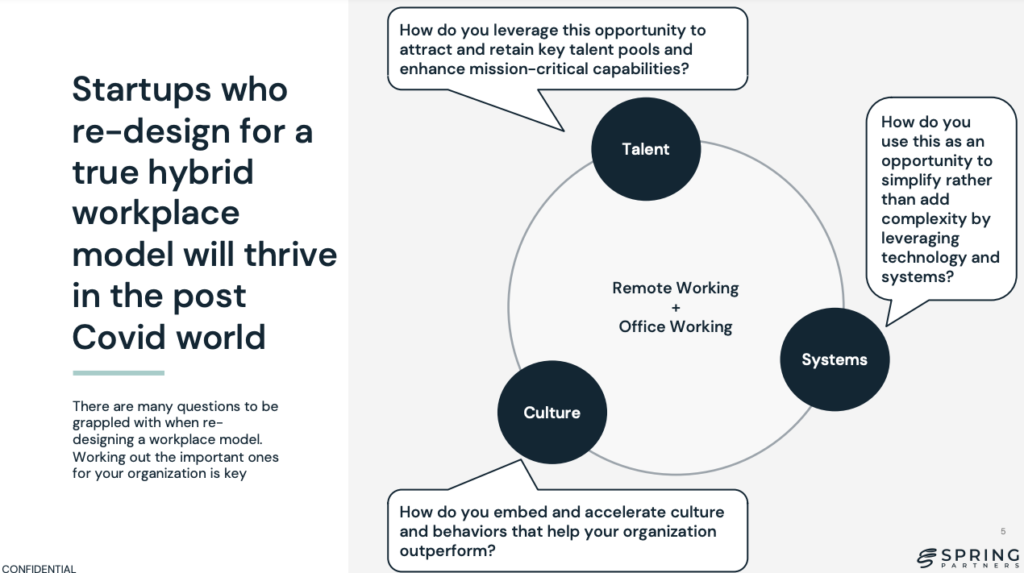A Gartner study in late 2020 showed that 74% of companies are planning a permanent shift to some form of remote working. In our final blog of this Future of Work series, we explore how planning your future workplace model in a deliberate and intentional way could dramatically improve your working practices, transform culture and enable a faster return to delivering on your business strategy.
Mass vaccination in the UK is reaching younger workers, so a return to the office in some capacity over the next few months seems likely. But we know that many people have come to like working from home, saving the cost and time to commute, being more productive, and enjoying family time.
No single model will suit every organisation or every team within an organisation, so a range of hybrid models are emerging, along a spectrum of scheduled-on-site (where employees alternate regular days or weeks in the office for collaboration) to connected-remote-working (where they are within a certain radius of the office and come in monthly for designated activities).

The approach requires some considered thinking and, according to The Economist, will likely have consequences for managers. These include employment law changes to protect workers and, potentially, deeper divisions between knowledge workers and those who have to be on-site. Inclusion and fairness is a vitally important input to designing new hybrid practices and processes and needs to be carefully considered.
Whilst there are clear benefits of hybrid models, such as enabling organisations to capitalise on the best global talent pools for the skills they require, there are also a whole range of operational constraints that need to be considered and some of the perceived benefits of remote models will need to be worked through carefully.
At Spring, we’re hearing that between 20-50% of workers will typically be in the office on any one day. The office will no longer be a place of daily work. Instead, it will be space for collaboration, socialising and team building – especially key for younger workers. Re-designing and future proofing office space to make them truly effective hybrid working environments will require both time and resources.
The return to the office is a unique, once-in-a-decade opportunity to pro-actively take stock and transform the operating model of the organisation to have a flexi-first culture, rather than just trying to recreate existing processes in a new way.
Such an organisational transformation will need to take account of prevailing external trends, technology enablers, and operational and regulatory constraints. We believe this will be the most important project companies will undertake this year, and intentional design is key.
Three questions execs should ask when designing the future role of the office:
- What is your vision for the office in the future, what do you want from it and what do you need to deliver the company’s strategic objectives?
- What can be done remotely and what needs to be done in person, in order to deliver on strategy? What are the critical drivers of productivity for each job and how is that affected by location? How does work get done in each team?
- What are your competitors doing and does your type of industry dictate specific regulatory requirements that mean activities must be in a certain environment?
Holding an exec. workshop can be a great way to distil this at a senior level and running an employee survey alongside will give insights into what has worked in the past year and what people want for the future. In designing these new hybrid models, leaders must consider their employees preferences and could consider using simple diagnostic survey tools to better understand teams’ personal preferences, work context and key tasks.
When considering what work can be done remotely, think about distilling the processes and decisions that drive different teams, which of these can be done remotely and which cannot. For example, 1:1’s may be fine online but learning and development workshops will need to be in person.
Taking this opportunity might just be a brilliant jumping-off point to fundamentally embed the best way for teams to execute and deliver on strategy. The executives we work with are seeing this as a once-in-a-lifetime opportunity to reset work – one that if we can get it right, will allow us to make our work lives more productive, flexible and purposeful.
Top Tips to determine the best hybrid model.
- Think big and think creatively, with a focus on eliminating bad practices and unproductive elements of historic working arrangements
- As we move through this transition, maintain the levels of transparency and communication with teams which enabled engagement through the pandemic
- Think about the optimum working week for those in different work environments. This is an opportunity to not only consider space and physical location as a flexible employer, but also time, potentially moving closer to an “anytime anyplace” model.
About Spring Partners
Spring was founded in September 2020 by Nicki Lynch and Joanne Thompson to be a new kind of consultancy purpose-built to work at pace for mission-driven tech start-ups, scaleups, and disruptors. Our clients are working on key societal issues like democratising work experience, creating a sustainable fashion revolution, or improving the collection rate of payments for small businesses to ease cash-flow tensions.
With backgrounds in consultancy at Bain & Company and experience as CEOs of tech start-ups, our focus is the commercial and operational challenges that come with success and fast growth.

